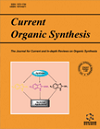- Home
- A-Z Publications
- Current Organic Synthesis
- Previous Issues
- Volume 11, Issue 4, 2014
Current Organic Synthesis - Volume 11, Issue 4, 2014
Volume 11, Issue 4, 2014
-
-
Synthesis of Oxazolo-, Thiazolo-, Pyrazolo-, and Imidazo-Fused Heterocycles by Multi-Component Reactions (Part 2)
More LessAuthors: Mohamed R. Shaaban and Ahmed H.M. ElwahyDevelopment of efficient routes to many kinds of fused heterocycles is an attractive area of research since these compounds constitute one of the most interesting divisions of organic chemistry. A majority of the compounds produced by nature as well as significant numbers of compounds synthesized in the industrial sector each year have heterocyclic rings as part of their structures. This survey research works on the speci Read More
-
-
-
Silica Sulfuric Acid and Related Solid-supported Catalysts as Versatile Materials for Greener Organic Synthesis
More LessAuthors: Manoj B. Gawande, Reza Hosseinpour and Rafael LuqueSolid acid catalysts are the best alternative to existing homogeneous protic acids, being less toxic, easy to handle and most importantly having the additional possibility to be reused several times. In recent years, silica has been employed as porous support to immobilize a series of acid species towards the design of novel solid acid catalysts. These materials have been employed in several organic reactions, including alkylation, a Read More
-
-
-
Antitubercular Natural Terpenoids: Recent Developments and Syntheses
More LessAuthors: Estibaliz Sansinenea and Aurelio OrtizTuberculosis (TB), mainly caused by Mycobacterium tuberculosis, is the leading killer among all infectious diseases worldwide and is responsible for more than two million deaths annually. The recent increase in the number of multi-drug resistant clinical isolates of M. tuberculosis has created an urgent need for the discovery and development of new antituberculosis leads. This review covers recent reports terpenoids that have d Read More
-
-
-
A Review of Amide Bond Formation in Microwave Organic Synthesis
More LessAuthors: Natalia Lukasik and Ewa Wagner-WysieckaMicrowave-Assisted Organic Synthesis (MAOS) is one of the most current trends in organic chemistry. Herein, both the most popular and new approaches in microwave-syntheses of very important linkage in Nature - amide bond - are overviewed and compared with conventional synthetic routes.
-
-
-
A Sustainable Approach to Bis-Indole Synthesis Using Propylene Carbonate as an Eco-Friendly Solvent
More LessWe prepared a series of bis-indole derivatives from different aldehydes and/or substituted isatins using molecular iodine as a catalyst and propylene carbonate as a “green” solvent. Simply stirring the components at room temperature produced high yield compound synthesis with a methodology that is clean, economical and efficient.
-
-
-
Synthesis of an Estradiol Derivative with an Adenosine-phosphate Mimic Linked at Position 16β
More LessAuthors: Amelie Talbot, Rene Maltais and Donald PoirierWe describe the synthesis and characterization of three compounds targeting the enzyme 17β-hydroxysteroid dehydrogenase type 1. The first one is a 4-aminobenzoyl-phenylacetic acid derivative designed as a mimic of adenosine-phosphate, the second one is an estradiol derivative having a decyl side chain at position 16β, and the third one is a hybrid compound with the adenosine-phosphate mimic covalently linked to the C1 Read More
-
-
-
Synthesis of Thiophenyl Schiff Bases via Buchwald-Hartwig Coupling of Piperazines to Quinoline Motif
More LessAuthors: Rahul V. Patel and Se Won ParkBuchwald-Hartwig coupling reaction was employed to furnish new class of substituted piperazine-fused thio-quinolinyl Schiff bases. Synthesis of thiocarbonyl quinoline moiety was attempted using Lawesson’s reagent followed by esterification achieved using ethyl bromoacetate in refluxing acetone. Substantial C-N coupling of various piperazine or piperidine bases to the C-6 position of quinoline ring system was accomplishe Read More
-
Volumes & issues
-
Volume 22 (2025)
-
Volume 21 (2024)
-
Volume 20 (2023)
-
Volume 19 (2022)
-
Volume 18 (2021)
-
Volume 17 (2020)
-
Volume 16 (2019)
-
Volume 15 (2018)
-
Volume 14 (2017)
-
Volume 13 (2016)
-
Volume 12 (2015)
-
Volume 11 (2014)
-
Volume 10 (2013)
-
Volume 9 (2012)
-
Volume 8 (2011)
-
Volume 7 (2010)
-
Volume 6 (2009)
-
Volume 5 (2008)
-
Volume 4 (2007)
-
Volume 3 (2006)
-
Volume 2 (2005)
-
Volume 1 (2004)
Most Read This Month
Article
content/journals/cos
Journal
10
5
false
en


